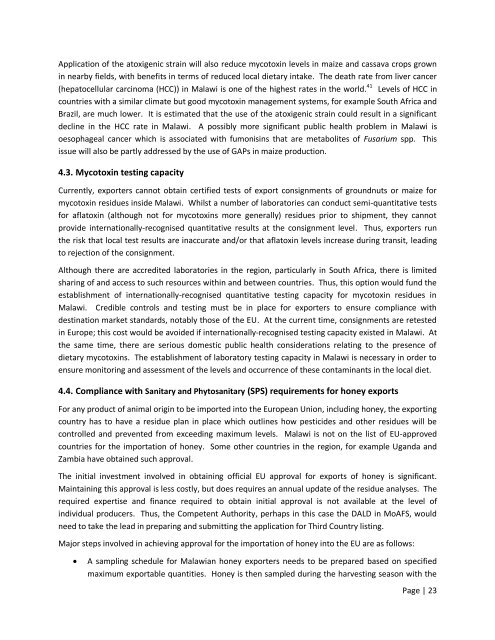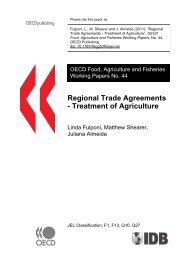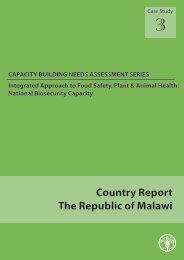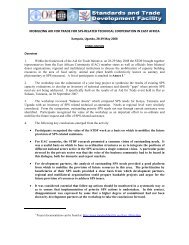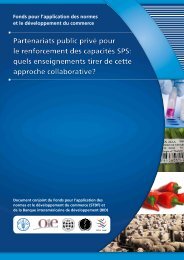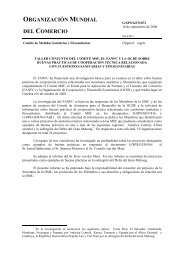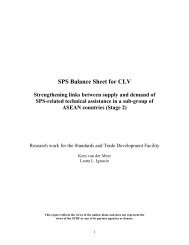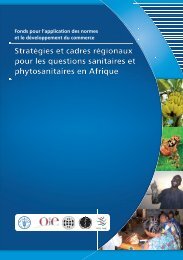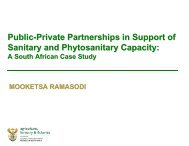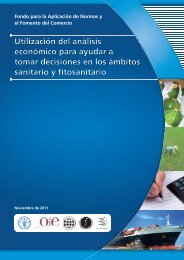MCDA Final Report Malawi - Standards and Trade Development ...
MCDA Final Report Malawi - Standards and Trade Development ...
MCDA Final Report Malawi - Standards and Trade Development ...
Create successful ePaper yourself
Turn your PDF publications into a flip-book with our unique Google optimized e-Paper software.
Application of the atoxigenic strain will also reduce mycotoxin levels in maize <strong>and</strong> cassava crops grown<br />
in nearby fields, with benefits in terms of reduced local dietary intake. The death rate from liver cancer<br />
(hepatocellular carcinoma (HCC)) in <strong>Malawi</strong> is one of the highest rates in the world. 41 Levels of HCC in<br />
countries with a similar climate but good mycotoxin management systems, for example South Africa <strong>and</strong><br />
Brazil, are much lower. It is estimated that the use of the atoxigenic strain could result in a significant<br />
decline in the HCC rate in <strong>Malawi</strong>. A possibly more significant public health problem in <strong>Malawi</strong> is<br />
oesophageal cancer which is associated with fumonisins that are metabolites of Fusarium spp. This<br />
issue will also be partly addressed by the use of GAPs in maize production.<br />
4.3. Mycotoxin testing capacity<br />
Currently, exporters cannot obtain certified tests of export consignments of groundnuts or maize for<br />
mycotoxin residues inside <strong>Malawi</strong>. Whilst a number of laboratories can conduct semi-quantitative tests<br />
for aflatoxin (although not for mycotoxins more generally) residues prior to shipment, they cannot<br />
provide internationally-recognised quantitative results at the consignment level. Thus, exporters run<br />
the risk that local test results are inaccurate <strong>and</strong>/or that aflatoxin levels increase during transit, leading<br />
to rejection of the consignment.<br />
Although there are accredited laboratories in the region, particularly in South Africa, there is limited<br />
sharing of <strong>and</strong> access to such resources within <strong>and</strong> between countries. Thus, this option would fund the<br />
establishment of internationally-recognised quantitative testing capacity for mycotoxin residues in<br />
<strong>Malawi</strong>. Credible controls <strong>and</strong> testing must be in place for exporters to ensure compliance with<br />
destination market st<strong>and</strong>ards, notably those of the EU. At the current time, consignments are retested<br />
in Europe; this cost would be avoided if internationally-recognised testing capacity existed in <strong>Malawi</strong>. At<br />
the same time, there are serious domestic public health considerations relating to the presence of<br />
dietary mycotoxins. The establishment of laboratory testing capacity in <strong>Malawi</strong> is necessary in order to<br />
ensure monitoring <strong>and</strong> assessment of the levels <strong>and</strong> occurrence of these contaminants in the local diet.<br />
4.4. Compliance with Sanitary <strong>and</strong> Phytosanitary (SPS) requirements for honey exports<br />
For any product of animal origin to be imported into the European Union, including honey, the exporting<br />
country has to have a residue plan in place which outlines how pesticides <strong>and</strong> other residues will be<br />
controlled <strong>and</strong> prevented from exceeding maximum levels. <strong>Malawi</strong> is not on the list of EU-approved<br />
countries for the importation of honey. Some other countries in the region, for example Ug<strong>and</strong>a <strong>and</strong><br />
Zambia have obtained such approval.<br />
The initial investment involved in obtaining official EU approval for exports of honey is significant.<br />
Maintaining this approval is less costly, but does requires an annual update of the residue analyses. The<br />
required expertise <strong>and</strong> finance required to obtain initial approval is not available at the level of<br />
individual producers. Thus, the Competent Authority, perhaps in this case the DALD in MoAFS, would<br />
need to take the lead in preparing <strong>and</strong> submitting the application for Third Country listing.<br />
Major steps involved in achieving approval for the importation of honey into the EU are as follows:<br />
<br />
A sampling schedule for <strong>Malawi</strong>an honey exporters needs to be prepared based on specified<br />
maximum exportable quantities. Honey is then sampled during the harvesting season with the<br />
Page | 23


